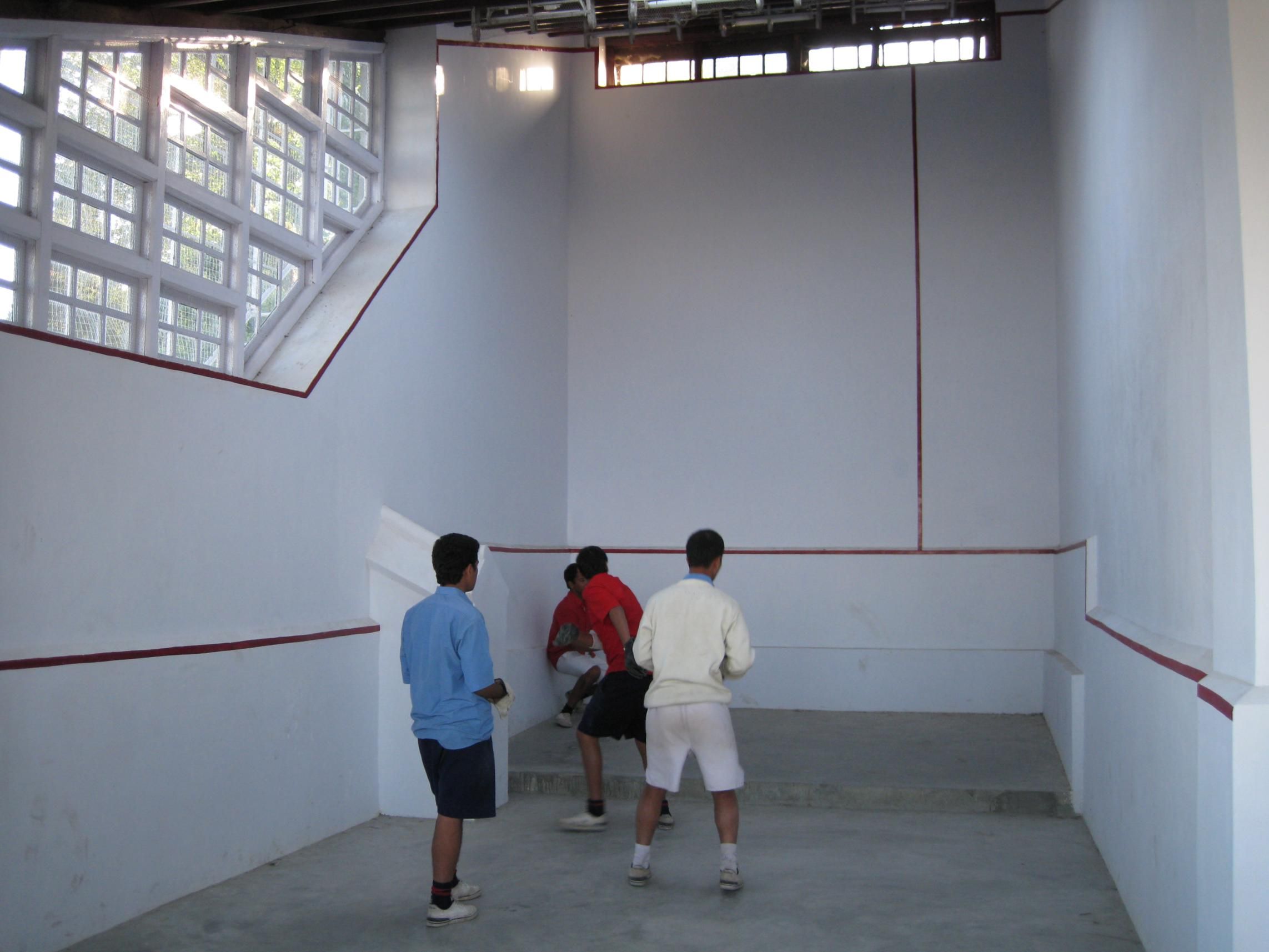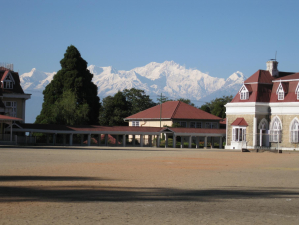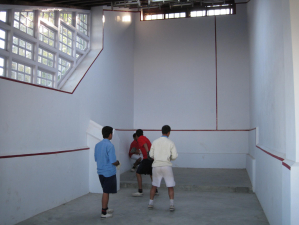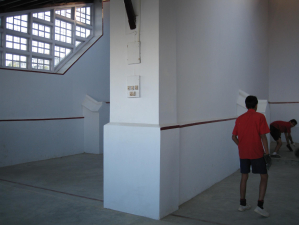
Fives in the Himalayas
St.Paul's School in Darjeeling is one of the more remote outposts of the game. Here are some reports on Fives at the school from the last 35 years.
Email from Peter Knowles to Mike Fenn (2008):
I got back yesterday from three weeks trekking in the Himalayas. We finished our trek a day early which gave me an extra day in Darjeeling. I decided to call in at St. Paul's School and met the Rector (Head) who immediately whisked me off to the fives courts where a house match was in progress with the master i/c watching (David Cecil). They gathered up some junior players and I did an impromptu coaching session for about an hour at their request. However, the good news is that they have just completed a total refurbishment of their two courts which were apparently in a bad way at what must have been very considerable expense. They are excellent (lights fitted and in an enclosed block) and appear perfectly standard (at the moment the whole of the shared wall is considered in play but a new red line is all that it would need). The boys were enthusiastic, clearly talented games players as one might expect given the cricket background in India. They were serving underarm but quickly changed when I showed the normal serve. There was a lot of volleying front and back but not much with the left hand.
However, they are down to their last fives ball and only have a few rather worn gloves so can only use one court at a time! I promised that the EFA would send them some gear (balls, gloves plus 1 or 2 coaching manuals) which I feel is the least we can do given the huge financial commitment to the game they have just made.
I will personally send them six balls for a starter this weekend - they break up at the end of November for three months (obviously I taught at the wrong school!). Perhaps the package could be sent at the start of their next term - I have the e-mail address of the master i/c.
Richard Tyler (1987)
In October 1987, I was choosing stop-overs for my trip to Australia. Delhi and the Taj Mahal appealed but it was by chance that Tony Hughes suggested playing Fives in Darjeeling. The guide book says that Darjeeling is "a jewel of a town set at the foothills of the Himalayas and the Queen of the Hill Stations, a bolt-hole for the British". It sounded like a place not to be missed.
Darjeeling certainly lived up to this description and in my opinion must be one of the most fascinating destinations in the world. In our 10 days there we became accustomed to the unusual. Within 40 hours of leaving Heathrow we found ourselves in the midst of a potential revolution. The local people were demonstrating for their independence from the erswhile rulers in Calcutta. Their chants of "Long Live Gorkaland!" soon became commonplace. Tony and I were guests of the Rector of St Paul's School in his colonial style house. The hospitality was excellent and even western-style food was readily available. However, we were not so much looked after by the Rector and his wife as by his three servants. This was our first introduction to the caste system and the realisation that you were not supposed to do anything yourself was very powerful. It was also very strange to see your clothes being washed by the local women in large wooden bowls, and being beaten clean on white stones.
The town of Darjeeling is spectacularly perched on a mountain side - a fact which makes walking between the various tiers particularly exhausting. It is an interesting mix between the colonial relics of the British hill-station and the grime and dirt of a bustling Indian town. At the top of the town are the four private Schools founded in Colonial times. Beneath them you find the Planter's Club, the Darjeeling Mountaineering Institute and the Windamere Hotel, and the Tourist shops, lower down still you have the local shops, the market, the taxi rank and the slums and shacks in which many of the 100,000 inhabitants live. It is amazing to think that these jerry-built huts with their tin roofs can survive the monsoon.
But what really makes Darjeeling is the view of Kanchenjunga - "the King of the Mountains". An absolutely huge mountain, in fact the third highest in the world, it dominates the scene though on a clear day you can see a whole line of peaks all over 20,000 ft, surely one of the highest horizons in the world.
What of Fives at St Paul's? The two courts were built in 1899 at the request of an incoming British rector. We were relieved to find that the pepperbox was indeed halfway along the left hand wall!. However, the game in Darjeeling did have its peculiarities such as cloud drifting through the court or indeed smoke from a Tibetan monk's incense fire. The lob into the mist and the cloud-high cuts were novel and attacking shots. At an altitude of 8,000ft. the ball travelled noticeably quicker and it was much harder to intercept and take volleys on the top step. The court was fairly dark, and the electric lighting only worked intermittently. Darjeeling suffers from a power shortage and consequently the supply would be cut every evening. We scored a major success in teaching the School Administrator the game. He was so impressed that he immediately had the Fives Court lights connected to the School reserve generator - never before contemplated - this was performed using the simple Indian technique of inserting the bare wires into the two sockets!
About 15 senior boys play Fives regularly at St. Paul's. They make light of the difficult playing conditions and considering their lack of opposition or coaching, play the game to a surprisingly high standard. We found them totally enthusiastic and willing to learn and as a result they improved enormously during our stay. We also introduced classes of junior boys to the game during their P.E. lessons. We hope time will be found in the School curriculum for them to play regularly.
The School has balls and sufficient gloves and the School players are totally aware of the rules. The School players are fit and have a good sense for the game. This we felt was due in part to the fanatical enthusiasm of the sub-continent for cricket! When England met India in the World Cup Semi-final during our visit, the Rector diplomatically found an obscure religious birthday to commemorate and declared a public holiday. Every master and boy in the School then crowded around one of the four T.V. sets. When India eventually lost, the length of the ensuing silence had to be experienced to be believed.
The School, of course, claim to be Indian Fives Champions but there are in fact courts at Kodaikanal, but the distance is over 3,000 miles - they talk of arranging a School match although the travelling time would be at least five days.
We would like to thank everyone at St. Paul's for their hospitality. In particular, I should like to mention the Rector, Mr Jeff Gardener and Pradip Mall the Master responsible for Fives. It should be noted that the School would welcome further visits from any members of the EFA. We both found it to be a most memorable experience.
Arindam Chaudhuri (School Eton Fives Captain 1983):
Origins of the Game
Chapels, as we all know, present a site of inspiration. The case with Eton Fives was no different! As the name suggests, the game originated in Eton, with a few variations, and is most popular there, there being over forty courts currently in existence there, the first four having been simultaneously constructed in 1840.
To return to Chapels, the Eton variation of the game originated outside the Etonian Chapel, at the foot of the stairs leading to its North door. An amazing arrangement of buttresses, drains, and ledges gave the court the form it has to-day.
Arrival at St Paul's
The game arrived at the hallowed portals of St.Paul's School, Darjeeling from Eton in 1899.
The game at St Paul's has proved a valuable pastime to generations of Paulites. Its popularity could perhaps be attributed to the lengthy and pressing monsoons. In seeking to evade the 'Monsoon Blues' as is termed the general feeling of depression incurred, the Fives Court affords sanctuary.
However the game is associated with a number of difficulties, these being as listed under:-
Equipment - the number of gloves as was being used did not come to the level required by the number of enthusiastic hands. Gloves freshly purchased were speedily demolished. We have lately solved this problem by obtaining more from the local cobbler as also from similar obscure sources of glove production.
Exposure - being, in comparison to very popular games like Cricket and Soccer, rather an obscure type of game, it seldom gets the backing enthusiam it should. In a school like St. Paul's though fixtures are held on a minor scale, the above mentioned being lacking does not give Eton Fives the forward momentum required. As a result, popularity wanes, and the familiar white ball bounces off the cream walls less often, though one cannot say any more that 1983 has been a dull year for 1983 St. Pauls Eton Fives. Boys even go to play at night! Yet, to prosper, one must have competition from nearby, which is lacking.
These two are the primarily problems the Eton Fives Club of St. Paul's has faced.
Fixtures
However, lately, we have been trying to have fixtures with schools abroad and in India (just one) and this, if it works, may provide essential propulsion. Having two of the three courts in Asia, thes are currently limited to games against Old Paulites. There is another in Kodaikanal, but we have been unable to keep in contact with the players there.
This year we had an enthusiastic tournament between the Old Paulites and our current pairs. The Current pairs won the tournament yet had much to learn from the Old hands about the technique of the game. On the other hand, each pair must develop its own strategy and techniques. This gives the game a very individualistic flavour.
Players
The fives population of St.Pauls would amount to something in the neighbourhood of forty. Sadly enough, internal competition is limited to about twelve pairs, seven of the foremost being:-
Arindam Chaudhuri and Sanjay Jain
Anurag Bhatnagar and Kuo Hsing Chiang
Imanul Haque and Sanjoy Ray Chaudhuri
Ratul Sood and Tashi Tshering
Deepak Gupta and Sudip Saha
Anjan Roy and Shib Shankar Roy
Sanjoy Chatterjee and Lokenath Ghosh
One can in the near future look forward to some expansion and increased scope for Fives players. To be optimistic is certainly not to be unreasonable - the game is definately worth the candle.



